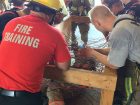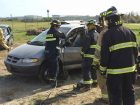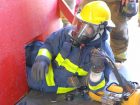
Features
Training
Trainers Corner: March 2016
As I got out of my truck in the Walmart parking lot, I heard a voice behind me say, “Hey buddy, any change?” I don’t remember the fellow saying, “Do you have any change?” and so as I went about my shopping, I thought about the way the question was phrased and applied it to my role as a training officer.
February 24, 2016
By
Ed Brouwer
Change is something we as instructors in Canadian fire services deal with constantly. During my 15 years writing this column, I have witnessed many changes, especially in the way we present our lessons. Just recently I (finally) threw out two garbage bags full of videocassettes. Each video represented hours of training modules; they all had hand-printed labels and were stored in protective hard plastic cases. These instructional tapes were once invaluable, now they sit at the back door waiting to be recycled. As for books, my office contains more than 100 hardcover fire-related volumes and training manuals. I value the printed page and enjoy the feel of a hardcover book, but for the most part they now collect dust. Some of the printed material is, well, old and outdated (I feel this way at times).
To answer the question, “Hey buddy, any change?” I’d have to say yes, there has been. There was a time when I’d have two or three books opened as I prepared for practice night. Now I can download a training video on any topic in seconds and insert it into a PowerPoint presentation ready to be used minutes later.
However, this instant practice material has come at a price. The hours we spent researching our topics and the time spent preparing overheads (remember them?) and flipcharts helped us know our topics. We wrote up the handouts and photocopied them; now we surf the net, cut and paste and hit print.
The first Trainer’s Corner column was about communication; it came complete with a practical hands-on layout any fire department could use. I’m pleased to say, we at Greenwood Fire Department in British Columbia still use that layout.
The intent for the Trainer’s Corner column is not so much to teach you how to perform various fire-ground tasks as it is to help you discover your particular gifts (talents) as an instructor. Trainers’ roles are more about learning to be effective communicators than experts in fire behaviour. We have both the challenge and honour of dealing with adult learners.
If you are new to instructing let me suggest that one of the first things you work at is determining your members’ learning styles. This will help you identify the conditions to help you teach most effectively.
For example, visual learners prefer seeing what they are learning. So, as instructors we should try to create mental images for them. For these types of learners, handouts (written instructions) are a must.
Auditory learners benefit from hearing the message or instruction being given. These adults prefer to have someone talk them through a process, rather than reading about it first. Over the years I have read exam questions to students who struggled to read. They had no trouble remembering verbal instructions, but struggled to comprehend what they read. Other learners prefer to do, so hands-on is where it is at for them.
Keep in mind that volunteer firefighters come to practice night expecting to learn something worth their time; they are trying to balance the demands of learning to be effective firefighters and the truckload of adult responsibilities. Look, it is pretty hard to get excited about going to practice if every one is about pumping or hose lays. Firefighters should strive for excellence in all areas.
Unfortunately, most of the fire service exams (multiple choice) available to us are, to put it bluntly, lame; they do not make firefighters think. And that, my friend, is the end goal.
Be honest with your crew. After 20 plus years of instructing in the fire service, I am quick to admit I do not have all the answers, and that is OK. Understand your role. A large part of my role as an instructor is to develop strengths and confidence in the members of Greenwood Fire Department, and you, the faithful readers of this column.
I have discovered that firefighters learn best by doing. Active participation should be the cornerstone of your training program. I use what I call the Bob-the-Builder system. The theme behind the kids show is to solve problems and get things done with a positive attitude. Bob the Builder and pals dig, haul and build together! With friends like Muck the dump truck and Dizzy the cement mixer, Bob and his business partner Wendy live in an imaginative world full of new experiences.
Basically the idea is to give your firefighter students a part in their training programs by tapping into what they are experienced in and passionate about.
On a personal note, please don’t think you have to be an expert at every aspect of fire fighting. Trainers just need to learn how to draw on the various experiences and talents found in their memberships. When I teach on building construction I call on Pat, a local contractor, to help me. When dealing with first response medical training I call on Larry or Rob, who are both paramedics.
So in closing let me ask you, “Hey buddy, any change?”
In the last year have you been able to create an environment that promotes interaction? Have you provided hands-on opportunities? Have you caused your members to think for themselves or do they just mimic others? Do they know why they do the things they do or are they simply following orders? Have you raised the bar in your training objectives?
I’ll challenge you with a question my son Casey, a firefighter in Osoyoos, asked regarding change: “If not now, when?”
In the year ahead, continue to train as though your crews’ lives depend on it, because they do. When firefighters find themselves in a fire-ground crisis they will seldom rise to the occasion, but they will default to their training. That’s why we train so hard.
Ed Brouwer is the chief instructor for Canwest Fire in Osoyoos, B.C., and training officer for Greenwood Fire and Rescue. Ed has written Trainer’s Corner for 15 of his 27 years in the fire service. Contact Ed at ebrouwer@canwestfire.org
Print this page


